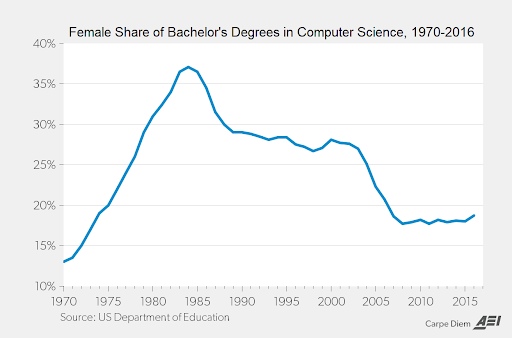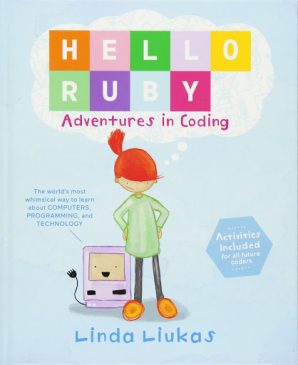Growing up, it seemed completely natural that my mother worked as a computer programmer. Terms like COBOL and C were commonplace in our house, and in the evenings while I did homework, she would pore over printed-out lines of code to find bugs. We’d often go into her office on weekends so she could figure out a problem in the server room (always bundled up in heavy sweaters because it was absolutely freezing in there to keep the mainframe cooled down). At the time, none of it seemed out of the ordinary.
One thing I did notice as a young girl, was that the majority of my mom’s co-workers, and certainly supervisors, were male. So I was genuinely surprised when I asked her about college in the 1980s, and she said that half of her classmates in programming classes were usually women! Doubting that statistic, I did a quick Google search and found that she wasn’t that far off compared to the rest of the US. In fact, in 1987, the average for women graduating with Computer Science degrees hit its peak at 38%. Furthermore, “computer science was the fastest growing college major and popular STEM discipline among women from the 1970s until the 1980s.”

Yet, according to the National Center for Women in Technology, the percentage of women graduating with computer science degrees in 2019 was 21%—just over half what it was over 30 years ago. Still, this is an encouraging increase, compared to the early 2010s when numbers had dipped between 12-15%.

The gender disparity in both academic pursuits and professional careers in computing has been present as an ongoing problem for decades. What is often overlooked, however, is that the low numbers we’ve grown accustomed to seeing were not always the case. How many of us make the false assumption that women have always been grossly underrepresented in tech?
Women in tech, specifically computing, experienced a slide in representation that we are only starting to overcome. Well before the days of “brogrammers,” women were well represented, and even led the way in the field. Women are credited as early innovators in computer science and technology: the first computer programmers of ENIAC during WWII worked to calculate missile trajectories for the US military, and Grace Hopper, the “mother of computing,” created the programming language COBOL, which revolutionized the field by allowing people to read code like a language for the first time.

From the 1950s, teams of women took on computing tasks that were originally dismissed by men as “clerical work,” and even throughout the 1960s, women were recruited for computing jobs. Women made gains in the field through the 1970s, and interest in Computer Science degrees hit a peak in the 1980s when personal computers (PCs) entered the home.
The stark decline in women in computing (and in tech more broadly) is attributed to various factors including college enrollment, discriminatory hiring practices and workplace cultures (in case the term “brogrammer” piqued your interest), harassment, stereotypes, and many other barriers to advancement throughout the last 70 years. These trends, unfortunately, led to significant loss of ground through the 1990s and 2000s, when many women felt discouraged or even restricted from careers in the tech industry whether directly, or indirectly; however, the research on women in STEM is extensive and provides insight to alter the trajectory.


So what can parents now do to reverse this trend? Work around diversifying stereotypes has been shown to increase girls’ interest in computer science and STEM careers. Exposure to positive representations of women in tech can influence and empower kids starting from a young age, giving them a sense of possibility. Sharing personal experiences with technology and career fields is ideal, but if you don’t have a frigid server room to visit, there are also many amazing resources dedicated to closing the gender gap in STEM education.
The Hello Ruby series makes the world of computers more understandable, inviting, and whimsical for children, while Andrea Beaty’s books like Ada Twist, Scientist inspire conversations about science with nods to the first computer programmer Ada Lovelace and physicist Marie Curie. Edutopia also has a reading list for girls in STEM, while shecancode’s reading list for women in tech features many women telling their own stories of career empowerment and equality for adults and older readers.
Games, apps, and toys geared towards girls in tech are also increasingly available. HerInteractive is a developer working in this space, with games based on Nancy Drew adventures, while many apps focused specifically on coding are working to incorporate Coding Tools Girls Will Love. Among companies “disrupting the pink aisle” of the toy store, GoldieBlox focuses on at-home STEAM education with extension activities for their products, and jewelbots offers “smart friendship bracelets” to introduce coding concepts through wearables to get preteen girls excited about technology. For those looking to dig in a bit more, organizations like Girls Who Code, Black Girls Code, or Girls in Tech are working to increase representation and bring diversity to the field, ultimately helping young women to explore the world of tech and to prepare for possible careers in the tech industry.
When I first started writing this post, I wanted to use the word “groundbreaking” to describe my mom’s career in technology. But now I realize that, while it was certainly impactful to me to have a strong female role model in my life, there were so many women before her that broke the ground and paved the way. Still, women (including my mom) continue to break barriers and work to keep a seat at a table. My mom was one of the few women on her team up through her retirement a few years ago—though I did see the balance shift a bit when she became the supervisor and was able to hire female programmers. (But that issue may warrant its own post!)
Let’s keep sharing and celebrating the stories of women in tech. And mothers, please keep letting your kids listen in on your Zoom meetings, or take them into that server room on weekends. Share your experiences and make the idea of women in tech feel completely ordinary. But take a sweater to that server room, because it really is cold in there!

